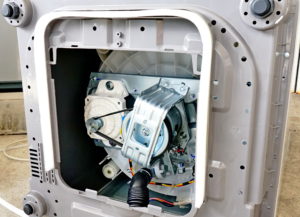Why is my washing machine making noises?
It’s not the end of the world if your washing machine is making weird noises, but you do need to check it out so that the problem doesn’t get worse; then it is the end of your washer’s world. Washing machines can make a variety of noises, from banging and rattling to squeaking and clicking. The noises can occur at any point during the wash cycle. In fact, the point at which your washer makes the noise can indicate the nature of the problem. We’re going to look at different washing machine noises, their causes, and possible DIY fixes.
5 Locations where washing machine noises are most likely to occur
The most common problem areas include:
- Shock absorbers
- Drum bearings
- Drive belt
- Pulley
- Innards
Shock absorbers (Front-loaders)
If your washing machine is making a banging noise you should probably check the shock absorbers. Like the shocks in your car, wear and tear takes a toll, and when this happens they can’t balance the tub/drum in the centre. You’re most likely to hear the washing machine banging on the spin cycle.
It’s possible to replace the shocks yourself, but sometimes the unbalanced drum causes further damage to the machine that only a professional technician can see and fix.
Suspension rods in top-loaders serve the same purpose as shocks in front-loaders. They also become worn and the tub/drum becomes unbalanced during the spin cycle. Sometimes the problem is as simple as replacing a weak spring on the rod, but you might have to replace the whole rod to fix the problem properly.
Drum bearings
According to Peter Tyson (of Peter Tyson Appliances), worn drum bearings are a very common problem which you may first be aware of when your washing machine makes a whirring noise – something like a low rumble. You can verify the problem by spinning the drum by hand to see if it generates noise. However, there are other problems that have the same identifier (for example, a dodgy drive belt), so the best way to pinpoint the cause is to remove the drive belt and then spin the drum.
If this doesn’t generate the noise but your washer is still whirring, you can test the bearings by seeing if you can lift up the drum manually. Check if the washing machine drum feels loose when lifting, and if so then it’s likely the bearings are worn.
If you think that the drum bearings are the problem then the best thing to do is contact a professional repairer. Special tools may be required to access, remove and replace worn bearings. In some cases, access is virtually impossible unless the entire drum is lifted out of the top of the machine. It’s not something you want to tackle yourself.
Drive belt
If your washer has a noisy spin cycle then it’s possible that the rubber on the drive belt is worn. The noise it makes is similar to the rumbling of faulty drum bearings. You can test it by spinning the drum by hand. If you can’t tell which problem is the reason for your washing machine making noise, call a professional repair-person.
Pulley

If your washing machine is knocking on the spin cycle then it could be the drive or drum pulley. The pulley is usually made of plastic can easily break due to severe wear and tear. You’ll have to open up your washer to see the drive belt and pulley. Peter Tyson says that it’s necessary to remove the drive belt to test the drum pulley. If it’s loose you may have found the reason your washing machine is making a knocking noise.
Innards
Sometimes the noise doesn’t come from a particular component. Sometimes it comes from items trapped in between components or in a pipe. Said items include coins, buttons, and the underwire from bras. That is right; Peter Tyson says that while having a bra wire stuck in your washer is rare, it can happen. If your washing machine is making a scraping noise, then the underwire is likely to be stuck between the tub and the drum.
You might be able to get it out via the sump hose or the dispenser hose. If you can’t see it or you can see it but you can’t quite reach, then turning the drum slowly can bring it closer to you. If you still can’t get it then you might need to remove panels to expose the innards and improve access.
While the wire isn’t really strong enough to cause serious damage to your washer, it can tear clothes, linen, and towels. It could also travel along the innards to one of the pumps and then block the pump, which can lead to far more serious problems.
Other …
These five examples are obviously not the only noises and problems that could potentially ail your washer. For example, your washing machine could be squeaking, or perhaps your washing machine is rattling.
You might find that your washing machine is making a loud noise during the wash cycle or perhaps during the rinse cycle only. The problem could be in the motor coupler, drum spider, or chassis.
Given the spectrum of problems and the crossover between the noises, a call to a professional technician is highly recommended. Also given the amount of fiddling required to locate a problem, you are more likely to unintentionally cause even more damage. Put your appliance in qualified hands and save yourself the risk of negating your insurance policy.
